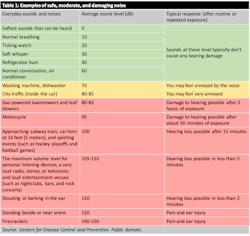Choosing the right set of earplugs to avoid work-related hearing loss
The first day of hygiene school starts with professionalism and infection control. We learn how to avoid cross contamination, how to protect ourselves from pathogens, how to prevent physical exhaustion by following positive workplace ergonomics, etc. One of the biggest challenges is following personal protective equipment (PPE) protocols.
The US Department of Labor defines PPE as “equipment worn to minimize exposure to hazards that cause serious workplace injuries and illnesses. These injuries and illnesses may result from contact with chemical, radiological, physical, electrical, mechanical, or other workplace hazards. Personal protective equipment may include items such as gloves, safety glasses and shoes, earplugs or muffs, hard hats, respirators, or coveralls, vests and full body suits.”1
Knowing the signs of hearing loss, the acceptable level of work-related noises, the types of products available, and how to choose the right fit may help to prevent work-related hearing loss. This article addresses how dental hygienists can protect their ears.
What are the signs of hearing loss?
Prevention and early detection of work-related hearing loss is very important. Understanding the signs of hearing loss can help us to take action to prevent further damage to the ears. The Centers for Disease Control and Prevention (CDC) recognizes 10 signs of hearing loss.2
- Speech and other sounds seem muffled
- Difficulty hearing high-pitched sounds (e.g., birds, doorbell, telephone, alarm clock)
- Difficulty understanding conversations when you are in a noisy place, such as a restaurant
- Difficulty understanding speech over the phone
- Trouble distinguishing speech consonants (e.g., difficulty distinguishing the difference between s and f, between p and t, or between sh and th in speech)
- Asking others to speak more slowly and clearly
- Asking someone to speak more loudly or repeat what they said
- Turning up the volume of the television or radio
- Ringing in the ears
- Hypersensitivity to certain sounds (certain sounds are very bothersome or create pain)2
Any of these signs could be of enough concern to see a specialist or an audiologist. However, preventing further damage is a measure that needs to be taken. Being aware of the environment’s noise level and knowing what constitutes a healthy noise level are necessary when choosing the right prevention method.
What is a safe noise level?
The practice of dental hygiene requires constant use of noisy equipment, including ultrasonic, piezo, suction, and slow-speed handpieces. Music or television, people talking, compressors, lab work, and equipment in other operatories are additional sources of noise. Noises above 70 decibels (dB) for a prolonged time may cause hearing issues.3 Table 1 shows safe, moderate, and damaging levels of noise exposure. Normal conversation is at 60 dB. If you have to raise your voice to be heard, the surrounding noise level is above 85 dB.3
Additionally, the National Institute for Occupational Safety and Health (NIOSH) suggests no more than 85 dB of noise exposure in eight hours; this number is set at 90 dB by OSHA.4 To measure how damaging our environment noises are, we should consider the duration and the exposure level.4 Table 2 shows the exposure level and the allowed time for each level. For instance, OSHA suggests no more than 90 dB of noise exposure in eight hours. If this number increases to 95 dB, the duration should not exceed four hours; otherwise, the prolonged exposure will cause hearing issues and possible hearing loss.
Noise levels in dental offices
Knowing that the maximum noise exposure or permissible exposure limit (PEL) in a day is 90 dB for eight hours per OSHA4 or 85 dB per NIOSH,4 it can be very concerning that the average noise level in a dental office is from 60 dB to 99 dB.5 According to Table 2, one will reach the 100% noise dose in two hours after being exposed to 100 dB per OSHA and 91 dB per NIOSH.4
Almost every piece of equipment in a dental office makes some noise.6 Ultrasonic scalers are around 83 dB, although the newer ones advertise noise reduction.6 The exposure levels are about 77 dB for high-volume suction and 75 dB for low-volume suction.6
The following scenario is an example of a dental office noise level that is higher than the PEL. A hygienist is using the ultrasonic for 20 minutes with low-volume suction. The dentist in the next operatory is using the high-speed handpiece with both high- and low-volume suction running. There is background music, people are talking, an assistant is trimming and adjusting a dental model in the lab, and a child is crying. All of these factors may increase the noise level.3,4,5,6 This is in addition to our normal daily noise exposure such as traffic, sirens, children playing, etc.
Prolonged exposure to an unhealthy noise level will increase the chance of hearing loss.3 One way to avoid this is by taking preventive measures, acknowledging any hearing loss signs and symptoms, and having regular check-up appointments with an audiologist.3 Hygienists should consider wearing a set of earplugs. Earplugs are rated according to the degree of protection using the noise reduction rating (NRR).7
How to choose the right earplugs based on NRR
The Environmental Protection Agency (EPA) developed the noise reduction rating (NRR), which is a measurement unit for evaluating noise reduction equipment.8 As mentioned earlier, on average, dental offices produce a noise level of 60 to 99 dB.5 Therefore, determining the right earplug is crucial. With all the different NRR levels in the market, one may wonder how to choose the right one. OSHA explains the calculating process for choosing the right set of earplugs.7,9 To illustrate, an earplug of 20 NRR will be calculated in a work environment with a 95 dB noise level for eight hours.
First, deduct 7 from 20 if the noise level is measured in A-weighted decibels (dBA), which is the human’s average hearing frequency.10 Next, a 50% correction factor will be applied since the laboratory-obtained measurements cannot be achieved in a real environment.7 Third, the noise level will be deducted from the new NRR number.7
20 - 7 = 13
13 x 50 %= 6.5
95 - 6.5 = 88.5
To summarize, the above calculation shows that if someone is exposed to 95 dBA of sound for eight hours and wears a pair of earplugs with 20 NRR, the sound level will be reduced to 88.5 dBA, which is still above the allowed level of 85 dBA for NIOSH; however, it falls under the OSHA PEL.4 Of course, one must consider the noise level of their office, the exposure time, the existing hearing damage, and other considerations. Discussing any concerns and issues with one’s physician or an audiologist may help to choose the right NRR level.
In a very noisy office with multiple operatories, different sound levels, and old equipment that produces a higher level of noise, one might consider using a higher level of NRR. Based on OSHA calculation, at 99 dB noise level for eight hours, 35 NRR earplugs can reduce the noise to an allowable level of 85 dB.7
One thing that must be considered is the ability to hear our patients and be aware of our surroundings while wearing the earplugs. Therefore, choosing the right NRR is crucial. As normal conversation noise level is measured around 60 dB3, if a hygienist is unable to hear his or her patient, then the NRR level is too high and a proper set of earpieces must be considered.
Wearing earplugs effectively
It is important to wear earplugs correctly to benefit from their protective measures. Nodoushan et al. found that individuals who wore a set of 25 NRR earplugs properly reduced the noise level 2.5 times more than the group that wore it with no training.11 This significant number emphasizes the importance of choosing the right NRR and wearing the earplugs correctly. CDC recommends the roll-pull-hold technique when wearing a soft foam earplug.12 This technique can also be used for silicone earplugs.
Conclusion
Dental hygienists should protect their ears and hearing. Knowing the noise level of our workplace, wearing proper earplugs, utilizing the earplugs correctly, and discussing any concerns with an audiologist may prevent hearing loss.
References
1. United States Department of Labor. Personal Protective Equipment. OSHA website. https://www.osha.gov/SLTC/personalprotectiveequipment/. Accessed January 9, 2020.
2. Centers for Disease Control and Prevention. How do I know if I have hearing loss caused by loud noise? CDC website. https://www.cdc.gov/nceh/hearing_loss/how_do_i_know_if_i_have_hearing_loss.html#10-signs. Accessed January 9, 2020.
3. Centers for Disease Control and Prevention. What noises cause hearing loss? CDC website. https://www.cdc.gov/nceh/hearing_loss/what_noises_cause_hearing_loss.html. Accessed January 9, 2020.
4. National Institute for Occupational Safety and Health (NIOSH). Noise and hearing loss prevention: Guidance and regulations. CDC website. https://www.cdc.gov/niosh/topics/noise/reducenoiseexposure/regsguidance.html Accessed January 9, 2020.
5. ADA Center for Professional Success. Safety tips to prevent hearing loss. ADA website. https://success.ada.org/en/wellness/safety-tips-to-avoid-hearing-loss. Accessed January 17, 2020.
6. Chang HH, Lee MS, Hsu YC, Tsai SJ, Lin CP. Comparison of clinical parameters and environmental noise levels between regular surgery and piezosurgery for extraction of impacted third molars. J Formosan Med Assoc. 2015;114(10):929-935. https://doi.org/10.1016/j.jfma.2014.02.003
7. Occupational Safety and Health Administration. Methods for estimating HPD attenuation. OSHA website. https://www.osha.gov/SLTC/noisehearingconservation/attenuation.html. Accessed January 17, 2020.
8. United States Department of Labor. Occupational Safety and Health Administration. OSHA website. https://www.osha.gov/laws-regs/regulations/standardnumber/1910/1910.95AppB. Accessed January 17, 2020.
9. Occupational Safety and Health Administration. Permissible noise exposure. OSHA website. https://www.osha.gov/SLTC/noisehearingconservation/pel.html. Accessed January 17, 2020.
10. Frequency weightings—A-weighted, C-weighted or Z-weighted? NoiseMeters website. https://www.noisemeters.com/help/faq/frequency-weighting. Accessed January 17, 2020.
11. Nodoushan MS, Mehrparvar AH, Jahromi AT, Safaei S, Mollasadeghi A.Training in using earplugs or using earplugs with a higher than necessary noise reduction rating? A randomized clinical trial. Int J Occup Environ Health. 2014;5(4):187-193. https://pdfs.semanticscholar.org/bc29/e508b657f07db9597586fc4fb6e3d003fc3e.pdf. 2014. Accessed January 25, 2020.
12. National Institute for Occupational Safety and Health (NIOSH). How to wear soft foam earplugs. CDC website. https://www.cdc.gov/niosh/mining/content/earplug.html. Accessed January 25, 2020.
Sahar Attari, BSDH, is a registered dental hygienist with more than five years of experience as a clinical dental provider in general practice settings. She is very involved in patient education and office production to improve the health of patients and the revenue of her office. She obtained her bachelor’s degree in dental hygiene with emphasis on teaching and education development. For more information, email her at [email protected].









